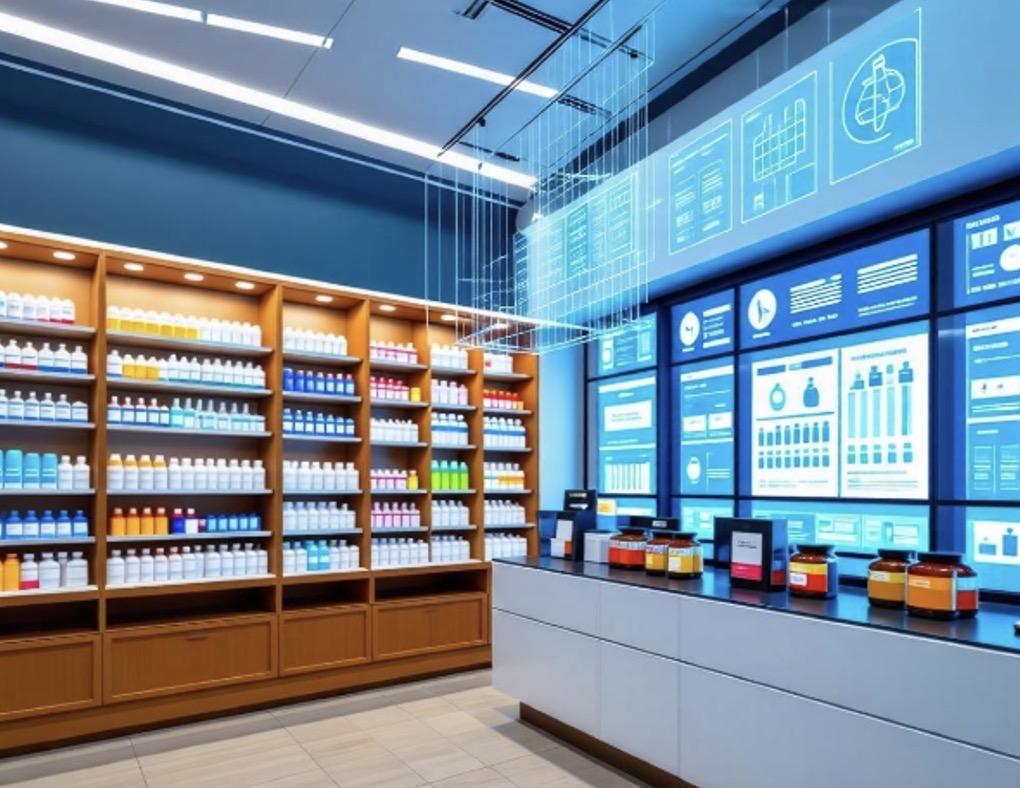Pharmacies, long considered pillars of the healthcare system, are often plagued by long queues, inefficiencies, and slow processes that frustrate patients and challenge pharmacists. Despite advancements in medical technology, many pharmacies continue to rely on outdated methods for prescription filling, inventory management, and patient care.
This stagnation not only hampers operational efficiency but also impacts patient outcomes, as errors and delays in medication dispensing can have serious health consequences. Transforming pharmacies with AI is essential to address these issues, offering a pathway to streamline operations, enhance medication safety, and personalize patient care.
This article will delve into the ways AI is optimizing pharmacy operations, from inventory management to prescription accuracy, and will explore future innovations such as digital twins and 3D printing of medications, which promise to further personalize and streamline pharmaceutical care.
Current Inefficiencies in Pharmacies
Pharmacies worldwide are grappling with significant inefficiencies that hinder their ability to serve patients effectively. One of the most glaring issues is the prevalence of long queues and extended wait times.
According to a study done by Argolytics, average wait times for prescription fulfillment can range from 20 to 45 minutes, with peak periods seeing even longer delays. This inefficiency not only inconveniences patients but also leads to considerable frustration and decreased satisfaction, as highlighted by an analysis of online feedback from the patients 65% of patients cited long wait times as a primary source of dissatisfaction with their pharmacy experience.
This inefficiency not only frustrates customers but also imposes a considerable burden on pharmacy staff. “During our busiest times, it feels like we’re constantly playing catch-up,” says Jane Doe, a pharmacist with over 15 years of experience. “Patients get frustrated, and it affects the quality of care we’re able to provide.”
Operational inefficiencies compound these issues, particularly in the areas of manual prescription filling and inventory management. Traditional manual processes are time-consuming and error-prone, leading to frequent mistakes in prescription dispensing.
The Institute for Safe Medication Practices reports that approximately 1.3 million people in the U.S. are injured annually due to medication errors, many of which occur at the dispensing stage.
Inventory management also suffers from inefficiencies, with pharmacies often struggling to maintain optimal stock levels. A report by WHO indicated that stockouts and overstock situations contribute to significant financial losses and operational disruptions. These inefficiencies underscore the critical need for innovative solutions, such as AI, to enhance pharmacy operations and improve patient outcomes.
AI-Driven Solutions for Pharmacy Efficiency
Speed and Accuracy Improvements
AI can revolutionize the operational efficiency of pharmacies, primarily by automating routine tasks that traditionally consume significant time and resources. One of the most notable applications is in the automation of prescription entry and refill reminders.
AI algorithms can process prescription orders with remarkable speed and precision, significantly reducing the likelihood of human error. For instance, Amazon Pharmacy leverages AI to offer expedited same-day delivery services in select cities, showcasing AI’s potential to streamline operations and enhance patient care by shortening delivery times for essential medications.
Inventory Management
In addition to improving speed and accuracy, AI can play a crucial role in optimizing inventory management within pharmacies. Traditional inventory systems often struggle with maintaining optimal stock levels, leading to either surplus stock or critical shortages.
AI can predict medication demand with high accuracy by analyzing historical data and current trends, thereby minimizing stockouts and ensuring that pharmacies are well-stocked with necessary medications.
Detection of Prescription Fraud
AI’s capabilities extend beyond operational efficiencies to enhance security measures within pharmacies. Prescription fraud is a significant concern, with fraudulent prescriptions costing the healthcare system billions of dollars annually. AI systems are highly effective in identifying and preventing such fraud by analyzing patterns and anomalies in prescription data.
For example, AI can detect irregularities in prescription behavior, such as unusually high doses or frequent refills that deviate from a patient’s typical usage patterns. A case study from the Journal of Medical Internet Research illustrated how AI-driven tools successfully identified and flagged fraudulent prescriptions, leading to a substantial reduction in fraudulent activities. By integrating AI for fraud detection, pharmacies can safeguard against financial losses and ensure that patients receive medications safely and appropriately.

Enhancing Medication Safety through AI
AI is revolutionizing medication safety in pharmacies through several key mechanisms, significantly reducing risks and enhancing patient outcomes.
A. Drug Interaction Detection
AI is revolutionizing how pharmacies screen for dangerous drug interactions. Using natural language processing techniques, AI systems can analyze prescription information such as medication names, dosages, and durations to rapidly identify potential interaction risks. They accomplish this by cross-referencing the prescribed drugs against comprehensive structured databases like CredibleMeds, which contains over 10,000 documented drug-drug interactions.
Various studies show AI methods can outperform pharmacists in detecting multiple concurrent drug interactions, with accuracy rates upwards of 65-70%. When an interaction is flagged, the AI provides contextual details to the pharmacist, including severity classification (e.g. contraindicated), management recommendations, and alternative treatment options to consider.
This AI-powered evaluation occurs in real-time as prescriptions are processed, enabling issues to be addressed promptly before fulfillment. Continued machine learning enhances detection precision over time. By automatically screening for dangerous combinations, a study by Topol estimates AI is estimated to prevent 58,000 adverse drug events annually in the U.S. alone. This demonstrates the technology’s immense potential to elevate medication safety and quality of care.
B. Allergy and Contraindication Checks
AI also enhances safety by performing thorough allergy and contraindication checks. AI tools can instantly cross-reference patient allergies and medical conditions with prescribed medications, flagging any potential issues.
Research from BMC Medical Informatics and Decision Making indicates that AI systems can reduce the incidence of allergic reactions and contraindications by up to 40%. This capability is particularly valuable in busy pharmacy environments where manual checks might miss critical details.
C. Dosage Optimization Based on Patient Data
AI’s ability to optimize drug dosages based on individual patient data represents another significant advancement. By analyzing factors such as age, weight, kidney function,genetic markers, comorbidities and concurrent medications, AI can recommend personalized dosages that maximize efficacy while minimizing side effects.
A study highlighted that AI-driven dosage recommendations could improve treatment outcomes for conditions like hypertension and diabetes by up to 20%. This personalized approach ensures that patients receive the most appropriate and effective medication regimens.
Personalization of Patient Care
AI is at the forefront of personalizing patient care in pharmacies, offering tailored solutions that significantly improve medication adherence, dosage accuracy, and patient education.
A. AI-Driven Medication Adherence Programs
Medication adherence is a critical component of effective healthcare, and AI-driven programs are proving to be highly effective in this area. By leveraging machine learning algorithms, these programs can predict which patients are at risk of non-adherence and intervene proactively.
For example, a study published by the Centers for Disease Control and Prevention found that AI-based adherence programs could improve medication adherence rates by up to 50%. These programs often use reminders, personalized messages, and even virtual health assistants to ensure patients take their medications as prescribed, thereby enhancing treatment outcomes and reducing hospital readmissions.
B. Personalized Dosage Recommendations
AI is also instrumental in providing personalized dosage recommendations. By analyzing a variety of patient-specific data, including genetic information, lifestyle factors, and clinical history, AI algorithms can determine the optimal dosage for each individual.
C. Tailored Patient Education and Counseling
Tailored patient education and counseling are other areas where AI is making a significant impact. AI systems can provide customized educational materials and counseling sessions based on individual patient needs and preferences.
AI tools can deliver information in various formats, such as video tutorials, interactive modules, and personalized health tips, ensuring that patients receive the knowledge they need to manage their conditions effectively.

Future of Pharmacies with AI
The future of pharmacies is set to be revolutionized by the integration of AI technologies, particularly through the concept of digital twins. Digital twins, which are virtual replicas of physical entities, offer unprecedented opportunities for personalized healthcare. By creating a digital twin of a patient, healthcare providers can simulate various scenarios, including drug interactions and dosage effects, to tailor treatments precisely to individual needs.
Digital Twins and Personalized Medicine
Digital twins in healthcare are detailed virtual models that replicate a patient’s physiological and biological characteristics. These models are built using extensive patient data, including genetic information, medical history, lifestyle factors, and even real-time health metrics.
According to a report by JMIR, the development of digital twins has the potential to transform personalized healthcare by providing a dynamic and interactive platform for patient-specific treatment plans. This technology allows for continuous monitoring and updating, ensuring that the virtual model remains accurate and reflective of the patient’s current state.
Simulation of Drug Interactions and Dosages
One of the most promising applications of digital twins is in the simulation of drug interactions and dosages. By leveraging AI algorithms, digital twins can predict how different medications will interact within a specific patient’s body, significantly reducing the risk of adverse reactions.
A study published in JMIR highlighted that digital twin technology could simulate drug interactions with up to 90% accuracy, providing a safer and more effective means of managing complex medication regimens.
Furthermore, digital twins can optimize drug dosages by simulating how different doses will affect the patient’s unique physiology. This personalized approach ensures that patients receive the most effective dose with the least risk of side effects.
Impact on Future Pharmacies
The integration of digital twins into pharmacy practice will enable pharmacists to offer highly personalized care, moving beyond the one-size-fits-all approach to medication management.
Pharmacies will be able to leverage these virtual models to test and adjust treatment plans in a risk-free environment before applying them to patients. This not only enhances safety and efficacy but also increases patient trust and satisfaction.
According to a forecast by QY Research, the adoption of digital twin technology in healthcare could lead to a 20% reduction in adverse drug events and a 30% improvement in treatment outcomes.
3D Printing in Pharmacies
The integration of 3D printing in pharmacies is poised to revolutionize the pharmaceutical landscape by enabling the on-demand printing of personalized medications. This technology allows pharmacists to create custom-tailored drugs that meet the specific needs of individual patients, which is particularly beneficial for those with unique dosage requirements or allergies to certain excipients in standard medications.
3D printing in pharmacies operates by using precise formulations of active pharmaceutical ingredients (APIs) and excipients to produce medications layer by layer. This method offers unparalleled flexibility in dosage forms, shapes, and release profiles.
For example, a study published in Advanced Drug Delivery Reviews highlights how 3D printing can produce multi-drug tablets that release medications at different times, enhancing treatment adherence and efficacy. Such personalized medications can significantly improve patient outcomes, especially for those with chronic conditions requiring complex medication regimens.
One of the most compelling advantages of 3D printing in pharmacies is its potential to reduce pharmaceutical waste and enhance treatment efficacy. Traditional manufacturing processes often result in excess production and wastage due to the need for batch processing and the expiration of unused medications.
In contrast, 3D printing enables the production of medications on an as-needed basis, minimizing waste. According to a report by the Journal of Pharmaceutical Sciences, the implementation of 3D printing in pharmacies could reduce medication waste by up to 65%.
Moreover, 3D printing allows for the precise tailoring of drug dosages to suit individual patient needs, which can lead to better therapeutic outcomes. For instance, personalized dosages can help achieve optimal drug plasma levels, reducing the risk of side effects and improving overall efficacy. This approach aligns with the principles of precision medicine, where treatments are customized based on the genetic, environmental, and lifestyle factors of each patient.
Challenges and Considerations
While AI shows enormous promise for advancing pharmacy services, several challenges must be addressed to ensure its safe, effective integration.
Data privacy and security concerns will be a major barrier to overcome. As AI systems require access to vast amounts of sensitive patient health records, protocols must be exceptionally robust to prevent unauthorized access or disclosure. Even accidental breaches could seriously undermine public confidence in these new technologies.
Regulatory compliance and approval processes for new AI tools present another hurdle, especially as their roles expand into direct clinical decision-making. Extensive validation through well-designed clinical trials will be necessary to prove safety and efficacy standards before full adoption. This may slow integration timelines.
Seamless integration within existing pharmacy infrastructure and interoperability with other healthcare IT systems is a challenge due to legacy technologies currently in place. AI solutions require smooth information exchange, which relies on the modernization of data formats and interfaces.
Successful change management involving comprehensive staff training on AI capabilities and limitations will be critical. As routine tasks are automated or augmented, employees must learn new responsibilities involving complex AI-assisted work. Support is necessary throughout this process to ensure adoption success.
Other issues like algorithmic bias, explainability of results, long-term performance monitoring, and system auditing will also need to be addressed through strict governance and evaluation frameworks. Only by surmounting these challenges can the full benefits of clinical AI be safely achieved.
Conclusion
The integration of AI in pharmacies heralds a new era of personalized, efficient, and safer patient care. The ability to detect drug interactions, optimize dosages, and tailor patient education through AI-driven solutions significantly enhances medication safety and adherence. The advent of digital twins and 3D printing technologies promises to revolutionize personalized treatments, allowing for on-site, patient-specific medication production that improves therapeutic outcomes and compliance.
However, the path forward is not without its challenges. Ensuring robust data privacy and security measures, navigating complex regulatory landscapes, achieving seamless integration with existing healthcare systems, and equipping pharmacy staff with the necessary skills and knowledge are critical to the successful deployment of AI in pharmacy practice.
This future demands an “all hands on deck” collaboration between innovators, regulators, pharmacists and engineers. Only then can we achieve AI’s full capacity to revolutionize health systems worldwide and place personalized patient care front and centre.
Found this article interesting?
P.S. Here are 5 ways we can help you accelerate your Pharma AI results:
1. Follow Dr Andrée Bates LinkedIn Profile Now
Dr Bates posts regularly about AI in Pharma so if you follow her you will get even more insights.
2. Listen to our AI for Pharma Growth Podcast
Revolutionize your team’s AI solution vendor choice process and unlock unparalleled efficiency and save millions on poor AI vendor choices that are not meeting your needs! Stop wasting precious time sifting through countless vendors and gain instant access to a curated list of top-tier companies, expertly vetted by leading pharma AI experts.
Every year, we rigorously interview thousands of AI companies that tackle pharma challenges head-on. Our comprehensive evaluations cover whether the solution delivers what is needed, their client results, their AI sophistication, cost-benefit ratio, demos, and more. We provide an exclusive, dynamic database, updated weekly, brimming with the best AI vendors for every business unit and challenge. Plus, our cutting-edge AI technology makes searching it by business unit, challenge, vendors or demo videos and information a breeze.
Discover vendors delivering out-of-the-box AI solutions tailored to your needs.
Identify the best of the best effortlessly.
Anticipate results with confidence.
Transform your AI strategy with our expertly curated vendors that walk the talk, and stay ahead in the fast-paced world of pharma AI!
Get on the wait list to access this today. Click here.
4. Take our NEW and FREE AI for Pharma Assessment
When we analysed the most successful AI in biopharma and their agencies, we found there are very specific strategies that deliver the most consistent results year after year. This assessment is designed to give clarity as to how to achieve a successful outcome from AI.
The first step is to complete this short questionnaire, it will give us the information to assess which process is right for you as a next step.
It’s free and obligation-free, so go ahead and complete it now. Plus receive a free link to our a free AI tools pdf and our 5 day training (30 mins a day) in AI in pharma. Link to assessment here.
5. Learn more about AI in Pharma in your own time
We have created an in-depth on-demand training about AI specifically for pharma that translate it into easy understanding of AI and how to apply it in all the different pharma business units — Click here to find out more.

